How to Quickly Set Up a Mail Server on CentOS 7 with Modoboa
Setting up a mail server on Linux from scratch is a pain in the neck. This tutorial is going to show you how to quickly set up your own email server on CentOS 7 with Modoboa, saving you lots of time and headaches. Modoboa is a free and open-source mail hosting and management platform designed to work with Postfix SMTP server and Dovecot IMAP/POP3 server.
Note: The latest version of Modoboa is a little buggy on CentOS 7. I recommend using iRedMail instead of Modoboa to set up the mail server on CentOS 7.
Modoboa is written in Python, released under the terms of ISC license. At the time of writing, the latest version is v1.15.0, released on May 7, 2020. Main features of Modoboa are as follows:
- Modoboa by default uses the Nginx web server to serve the webmail client and web-based admin panel.
- Compatible with Postfix and Dovecot.
- Supports MySQL/MariaDB, and PostgreSQL database.
- Easily create unlimited mailboxes and unlimited mail domains in a web-based admin panel.
- Easily create email alias in the web-based admin panel.
- The webmail client provides an easy-to-use message filter to help you organize messages to different folders.
- It can help you protect your domain reputation by monitoring email blacklists and generating DMARC reports, so your emails have a better chance to land in the inbox instead of the spam folder.
- Includes amavis frontend to block spam and detect virus in email.
- Calendar and address book.
- Integration with Let’s Encrypt to get a valid SSL/TLS certificate.
- A policy daemon for Postfix that allows you to define daily sending limits for domains and individual accounts.
- Includes AutoMX to allow end users to easily configure mail account in a desktop or mobile mail client.
Step 1: Choose the Right Hosting Provider and Buy a Domain Name
To set up a complete email server with Modoboa, you need a server with at least 3GB RAM, because after the installation, your server will use more than 2GB of RAM.
It is highly recommended that you install Modoboa on a clean install of CentOS 7 server.
This tutorial is done on a $9/month Kamatera VPS (virtual private server) with 1 CPU and 3GB RAM. They offer a 30-day free trial.
Kamatera is a very good option to run a mail server because
- They don’t block port 25, so you can send unlimited emails (transactional email and newsletters) without spending money on SMTP relay service. Kamatera doesn’t have any SMTP limits. You can send a million emails per day.
- The IP address isn’t on any email blacklist. (At least this is true in my case. I chose the Dallas data center.) You definitely don’t want to be listed on the dreaded Microsoft Outlook IP blacklist or the spamrats blacklist. Some blacklists block an entire IP range and you have no way to delist your IP address from this kind of blacklist.
- You can edit PTR record to improve email deliverability.
- They allow you to send newsletters to your email subscribers with no hourly limits or daily limits, whatsoever.
- You can order multiple IP addresses for a single server. This is very useful for folks who need to send a large volume of emails. You can spread email traffic on multiple IP addresses to achieve better email deliverability.
Other VPS providers like DigitalOcean blocks port 25. DigitalOcean would not unblock port 25, so you will need to set up SMTP relay to bypass blocking, which can cost you additional money. If you use Vultr VPS, then port 25 is blocked by default. They can unblock it if you open a support ticket, but they may block it again at any time if they decide your email sending activity is not allowed. Vultr actually may re-block it if you use their servers to send newsletters.
Go to Kamatera website to create an account, then create your server in your account dashboard.
I recommend following the tutorial linked below to properly set up your Linux VPS server on Kamatera.
Once you created a server, Kamatera will send you an email with the server SSH login details. To log into your server, you use an SSH client. If you are using Linux or macOS on your computer, then simply open up a terminal window and run the following command to log into your server. Replace 12.34.56.78 with your server’s IP address.
ssh [email protected]
You will be asked to enter the password.
You also need a domain name. I registered my domain name from NameCheap because the price is low and they give whois privacy protection free for life.
Step 2: Creating MX Record and A Record in DNS
The MX record specifies which host or hosts handle emails for a particular domain name. For example, the host that handles emails for linuxbabe.com is mail.linuxbabe.com. If someone with a Gmail account sends an email to [email protected], then Gmail server will query the MX record of linuxbabe.com. When it finds out that mail.linuxbabe.com is responsible for accepting email, it then query the A record of mail.linuxbabe.com to get the IP address, thus the email can be delivered.
You can log in to your domain registrar’s website (such as NameCheap) to create DNS records.
In your DNS manager, create a MX record for your domain name. Enter @ in the Name field to represent the main domain name, then enter mail.your-domain.com in the Value field.
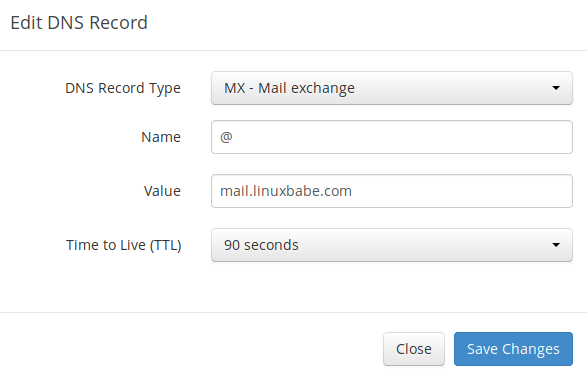
Note: The hostname for MX record can not be an alias to another name. Also, It’s highly recommended that you use hostnames, rather than bare IP addresses for MX record.
Your DNS manager may require you to enter a preference value (aka priority value). It can be any number between 0 and 65,356. A small number has higher priority than a big number. You can enter 0 for your email server, or accept the default value.
After creating MX record, you also need to create an A record for mail.your-domain.com , so that it can be resolved to an IP address. If your server has IPv6 address, be sure to add AAAA record as well.
If you use Cloudflare DNS service, you should not enable the CDN feature when creating A record for your mail server. Cloudflare does not support SMTP proxy.
Step 3: Set up Mail Server on CentOS 7 with Modoboa Installer
Log into your server via SSH, then run the following command to update existing software packages.
sudo yum update -y
I strongly recommend creating a sudo user for managing your server rather than using the default root user to improve server security. Run the following command to create a user. Replace username with your preferred username.
sudo adduser username
Set a password for this user.
sudo passwd username
Add this user to the wheel group in order to use sudo.
sudo gpasswd -a username wheel
Switch to the new user.
su - username
Download modoboa installer from Github.
sudo yum install git -y git clone https://github.com/modoboa/modoboa-installer
Modoboa is written in Python. Run the following command to install the necessary Python software.
sudo yum install -y openssl-devel python-virtualenv python-pip python3-pip sudo -H pip3 install pystache wheel django-braces
Then navigate to the modoboa-installer directory and create a configuration file. Replace example.com with your own domain name.
cd modoboa-installer
sudo ./run.py --stop-after-configfile-check example.com

Edit the configuration file installer.cfg with a command line text editor like nano.
sudo yum install -y nano sudo nano installer.cfg
To obtain a valid SSL/TLS certificate from Let’s Encrypt for your mail server, in [certificate] section, change the value of type from self-signed to letsencrypt.
type = letsencrypt
And change the email address from [email protected] to your real email address, which will be used for account recovery and important notifications. You will not be able to obtain and install Let’s Encrypt certificate if you use the default email address.

By default, Modoboa installer will install PostgreSQL database server, as indicated by the following lines in the config file.
[database] engine = postgres host = 127.0.0.1 install = true
If you would like to use MariaDB database server, then change the engine from postgres to mysql. (Modoboa will install MariaDB instead of MySQL.)

To save the file in Nano text editor, press Ctrl+O, then press Enter to confirm. Press Ctrl+X to exit.
We need to change a package name from amavisd-new to amavis with the following command.
sed -i 's/amavisd-new/amavis/g' modoboa_installer/scripts/amavis.py
Create Amavis database schema.
cp modoboa_installer/scripts/files/amavis/amavis_mysql_2.11.X.sql modoboa_installer/scripts/files/amavis/amavis_mysql_2.12.X.sql cp modoboa_installer/scripts/files/amavis/amavis_postgres_2.11.X.sql modoboa_installer/scripts/files/amavis/amavis_postgres_2.12.X.sql
Next, run the following commands to open port 80 and 443 in firewall, so we can access the web-based admin panel later.
sudo yum install -y firewalld
sudo systemctl start firewalld
sudo firewall-cmd --permanent --zone=public --add-service={ssh,http,https}
Reload firewall for the changes to take effect.
sudo systemctl reload firewalld
You should use a fully-qualified domain name (FQDN) as the hostname for your mail server, such as mail.example.com. Run the following command to set the hostname.
sudo hostnamectl set-hostname mail.example.com
We also need to verify if the DNS records are propagated to the Internet. Depending on which domain registrar you use, your DNS record might be propagated instantly, or it might take up to 24 hours to propagate. You can go to https://dnsmap.io, enter your mail server’s hostname (mail.example.com) to check DNS propagation status.
If your DNS record is propagated, run the following command to start the installation. (Please replace example.com with your main domain name such as linuxbabe.com. Do not use a sub-domain like mail.example.com in this command).
sudo ./run.py --interactive example.com
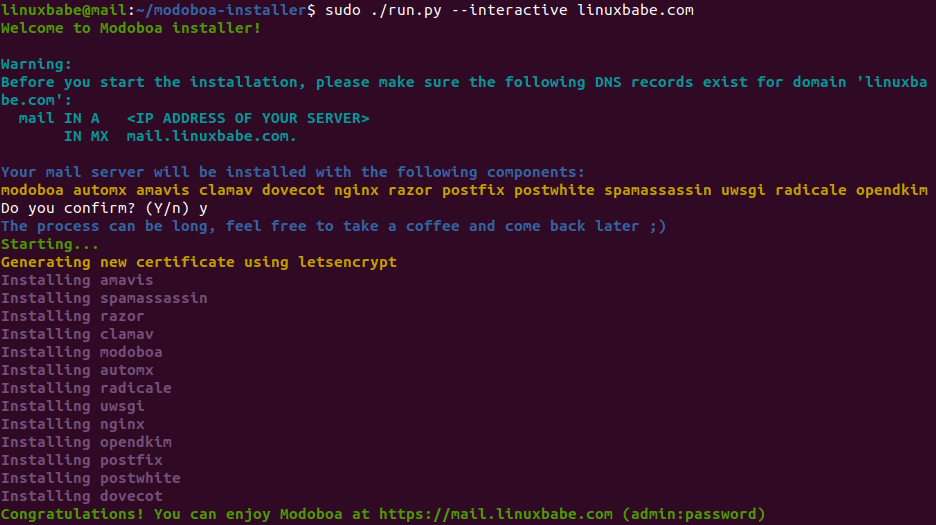
The installation process can take a while. It took 10 minutes on my server. If you see an error during the installation, you can use the --debug option to see more detailed output.
sudo ./run.py --interactive --debug example.com
After Modoboa finishes installation, you can log into the admin panel with username admin and password password.
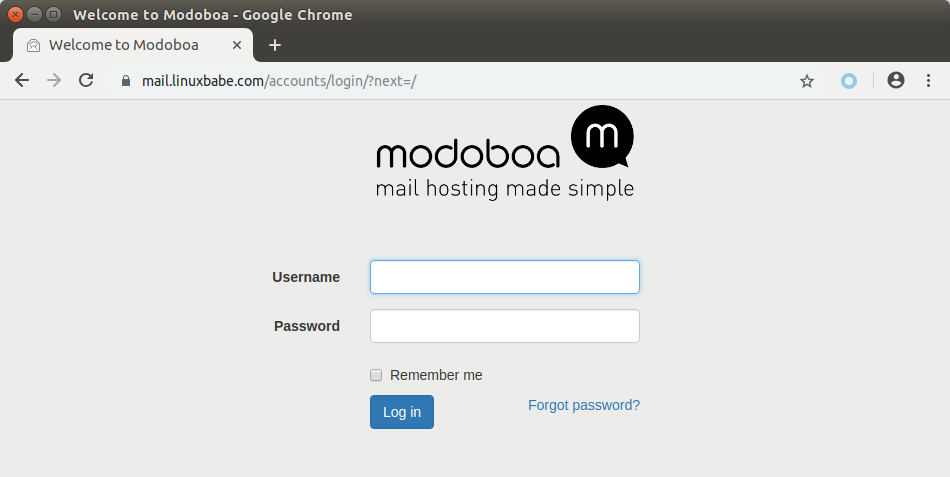
If the web page is displaying the “An internal error occurred” message, it’s likely that SELinux is preventing Nginx from access files in /srv/modoboa/instance/ directory. Run the following command to grant permissions.
sudo chcon -t httpd_sys_content_t /srv/modoboa/instance/ -R
Once you are logged in, you should go to Admin -> Settings -> Profile to change the password.
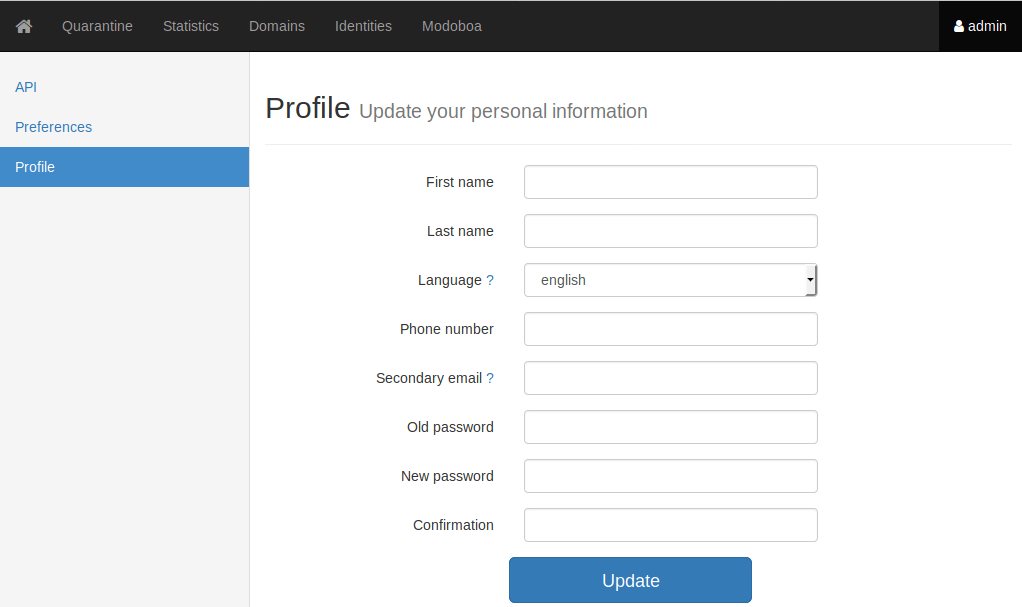
Step 4: Adding Mailboxes in Modoboa Admin Panel
Please note that the default admin account isn’t an email account. It can only be used to administer the mail server. To send emails, you need to add mailboxes with the admin account.
Go to Domains tab and click Add button to add a new domain.

Then enter your main domain name in the Name field. It is highly recommended that you enable DKIM signing, which can help with your domain reputation. In Key selector filed, you can enter a random word like modoboa. Choose 2048 for the key length.
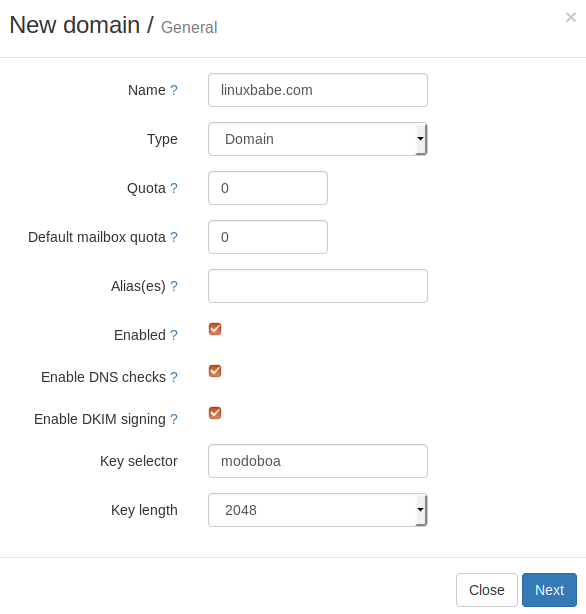
In the next screen, you can choose to create an admin account for this particular domain name. The SMTP protocol requires that a mail server should have a [email protected] address.
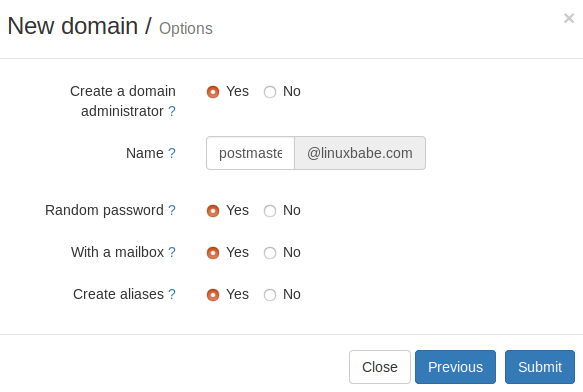
Click the Submit button and your domain name will be added in Modoboa.
To add email addresses, go to Domains tab and click your domain name.

Then click mailboxes.
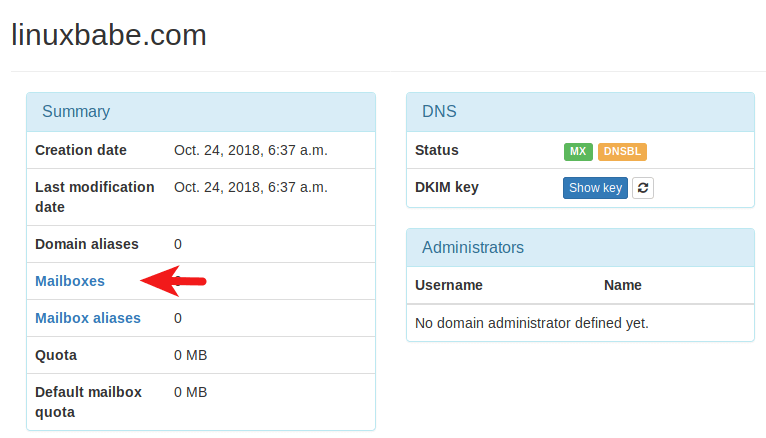
Click Add button and choose Account.

Then choose Simple user as the role. Enter an email address in Username field and enter a password.
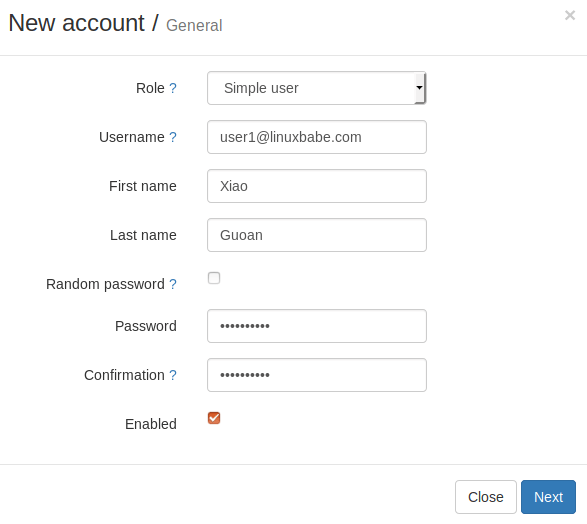
In the next screen, you can optionally create an alias for this email address.
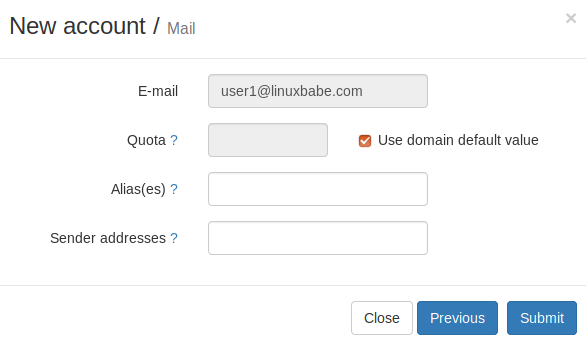
After clicking the submit button, the email address is created.
Step 5: Sending Test Emails
Before sending test emails, we need to run the following commands to open the SMTP and IMAP related ports in the firewall.
sudo firewall-cmd --permanent --add-service={smtp,smtp-submission,smtps,imap,imaps}
Reload firewall for the changes to take effect.
sudo systemctl reload firewalld
To login to the Modoboa webmail, you need to log out the admin account first and then enter the credentials for the email address.
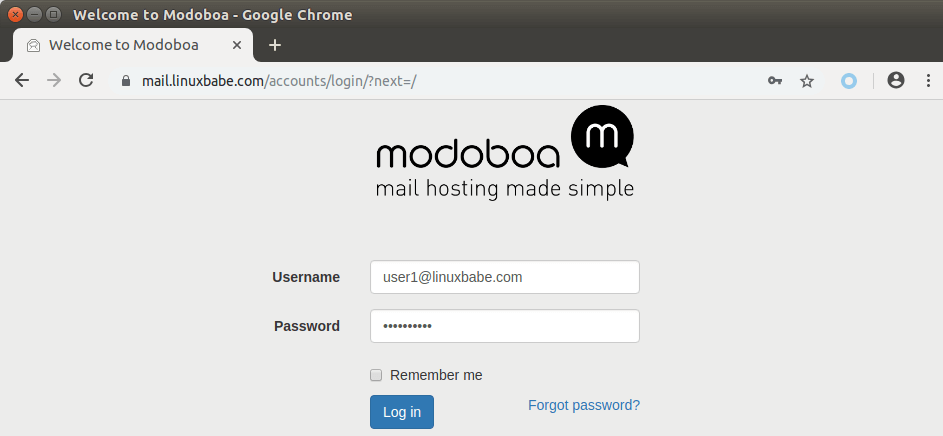
Once you are logged into Modoboa webmail, you can send a test email from your private email server to your other email address and vice versa.
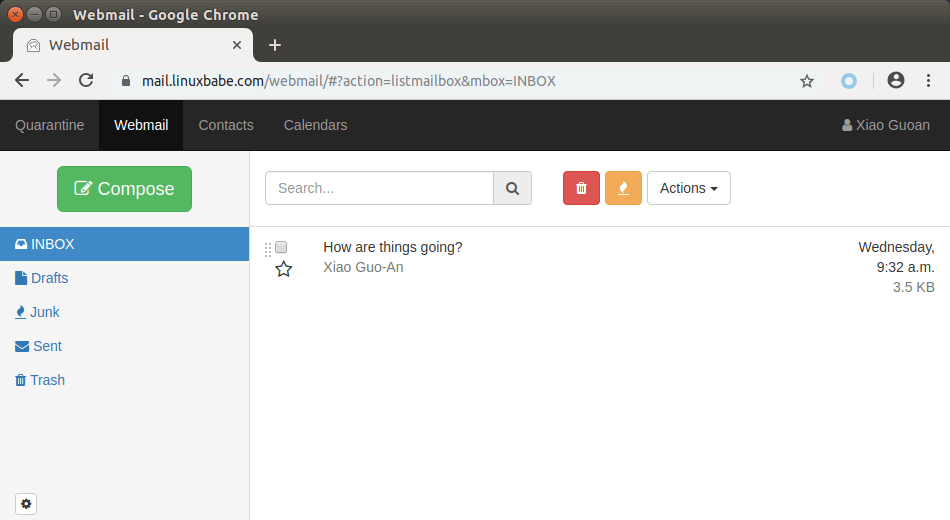
Inbound emails will be delayed for a few minutes, because by default Modoboa enables greylisting, which tells other sending SMTP server to try again in a few minutes. This is useful to block spam. The following message in /var/log/maillog indicates greylisting is enabled.
postfix/postscreen[20995]: NOQUEUE: reject: RCPT from [34.209.113.130]:36980: 450 4.3.2 Service currently unavailable;
However, greylisting can be rather annoying. You can disable it by editing the Postfix main configuration file.
sudo nano /etc/postfix/main.cf
Find the following lines at the end of the file and comment them out. (Add a # character at the beginning of each line.)
postscreen_pipelining_enable = yes postscreen_pipelining_action = enforce postscreen_non_smtp_command_enable = yes postscreen_non_smtp_command_action = enforce postscreen_bare_newline_enable = yes postscreen_bare_newline_action = enforce
Save and close the file. Then restart Postfix for the changes to take effect.
sudo systemctl restart postfix
Now you should be able to receive emails without waiting several minutes.
Checking if ClamAV is Running
ClamAV is used to scan viruses in email messages. ClamAV can use a fair amount of RAM. If there’s not enough RAM on your server, ClamAV won’t work properly, which will prevent your mail server from sending emails. You can check its status with:
systemctl status clamd@amavisd
If your ClamAV is always activating like below, you have a problem.

Check ClamAV logs.
sudo journalctl -eu clamd@amavisd
If you see the following error in the log,
LibClamAV Error: cli_loaddbdir(): No supported database files found in /var/lib/clamav
then you need to update the virus database with:
sudo freshclam
Now try to restart ClamAV.
sudo systemctl restart clamd@amavisd
Now check its log again.
sudo journalctl -eu clamd@amavisd
If you see the following line in the logs, that means your server doesn’t have enough RAM to run ClamAV.
daemonize() failed: Cannot allocate memory
You can add a swap file to your server to increase the total RAM on your server. (Note that using swap space on the server can greatly degrade server performance. If you want better performance, you should upgrade the physical RAM instead of using swap space.)
To add swap space on the server, first, use the fallocate command to create a file. For example, create a file named swapfile with 1G capacity in root file system:
sudo fallocate -l 1G /swapfile
Then make sure only root can read and write to it.
sudo chmod 600 /swapfile
Format it to swap:
sudo mkswap /swapfile
Output:
Setting up swapspace version 1, size = 1024 MiB (536866816 bytes) no label, UUID=0aab5886-4dfb-40d4-920d-fb1115c67433
Enable the swap file
sudo swapon /swapfile
Now your ClamAV should be active (running), and it won’t prevent your mail server from sending emails.
systemctl status clamd@amavisd

To mount the swap space at system boot time, edit the /etc/fstab file.
sudo nano /etc/fstab
Add the following line at the bottom of this file.
/swapfile swap swap defaults 0 0
Save and close the file. Then reload systemd.
sudo systemctl daemon-reload
Step 6: Checking If Port 25 (outbound) is blocked
Your ISP or hosting provider won’t block incoming connection to port 25 of your server, which means you can receive emails from other mail servers. However, many ISP/hosting providers block outgoing connection to port 25 of other mail servers, which means you can’t send emails.
If your email didn’t arrive at your other email address such as Gmail, then run the following command on your mail server to check if port 25 (outbound) is blocked.
telnet gmail-smtp-in.l.google.com 25
If it’s not blocked, you would see messages like below, which indicates a connection is successfully established. (Hint: Type in quit and press Enter to close the connection.)
Trying 74.125.68.26... Connected to gmail-smtp-in.l.google.com. Escape character is '^]'. 220 mx.google.com ESMTP y22si1641751pll.208 - gsmtp
If port 25 (outbound) is blocked, you would see something like:
Trying 2607:f8b0:400e:c06::1a... Trying 74.125.195.27... telnet: Unable to connect to remote host: Connection timed out
In this case, your Postfix can’t send emails to other SMTP servers. Ask your ISP/hosting provider to open it for you. If they refuse your request, you need to set up SMTP relay to bypass port 25 blocking.
Step 7: Using Mail Clients on Your Computer or Mobile Device
Fire up your desktop email client such as Mozilla Thunderbird and add a mail account.
- In the incoming server section, select IMAP protocol, enter
mail.your-domain.comas the server name, choose port 143 and STARTTLS. Choosenormal passwordas the authentication method. - In the outgoing section, select SMTP protocol, enter
mail.your-domain.comas the server name, choose port 587 and STARTTLS. Choosenormal passwordas the authentication method.
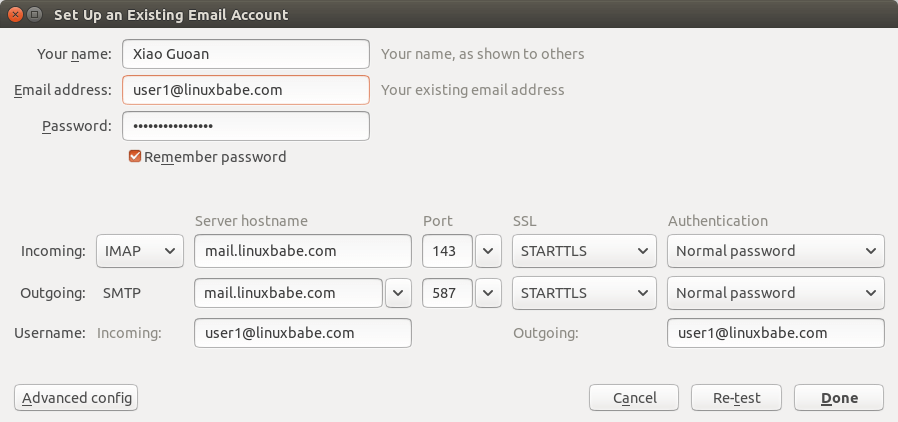
You can also use IMAP on port 993 with SSL/TLS encryption.
Step 8: Improving Email Deliverability
To prevent your emails from being flagged as spam, you should set PTR, SPF, DKIM and DMARC records.
PTR record
A pointer record, or PTR record, maps an IP address to a FQDN (fully qualified domain name). It’s the counterpart to the A record and is used for reverse DNS lookup, which can help with blocking spammers. Many SMTP servers reject emails if no PTR record is found for the sending server.
To check the PTR record for an IP address, run this command:
dig -x IP-address +short
or
host IP-address
PTR record isn’t managed by your domain registrar. It’s managed by the organization that gives you an IP address. Because you get IP address from your hosting provider or ISP, not from your domain registrar, so you must set PTR record for your IP in the control panel of your hosting provider or ask your ISP. Its value should be your mail server’s hostname: mail.your-domain.com. If your server uses IPv6 address, be sure to add a PTR record for your IPv6 address as well.
To edit the reverse DNS record for your Kamatera VPS, log into the Kamatera client area, then open a support ticket and tell them to add PTR record for your server IP addresss to point the IP address to mail.your-domain.com. It’s not convenient, you might think, but this is to keep spammers away from the platform, so legitimate email senders like us will have a great IP reputation.
SPF Record
SPF (Sender Policy Framework) record specifies which hosts or IP address are allowed to send emails on behalf of a domain. You should allow only your own email server or your ISP’s server to send emails for your domain. In your DNS management interface, create a new TXT record like below.
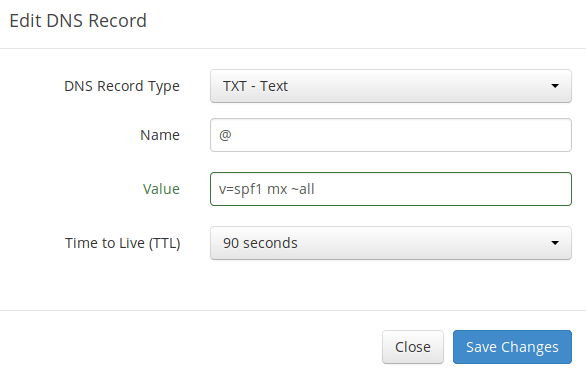
Explanation:
- TXT indicates this is a TXT record.
- Enter @ in the name field to represent the main domain name.
- v=spf1 indicates this is a SPF record and the version is SPF1.
- mx means all hosts listed in the MX records are allowed to send emails for your domain and all other hosts are disallowed.
- ~all indicates that emails from your domain should only come from hosts specified in the SPF record. Emails that are from other hosts will be flagged as forged.
To check if your SPF record is propagated to the public Internet, you can use the dig utility on your Linux machine like below:
dig your-domain.com txt
The txt option tells dig that we only want to query TXT records.
DKIM Record
DKIM (DomainKeys Identified Mail) uses a private key to digitally sign emails sent from your domain. Receiving SMTP servers verify the signature by using the public key, which is published in the DNS DKIM record.
When we were adding domain name in Moboboa admin panel earlier, we enabled DKIM signing, so the signing part is taken care of. The only thing left to do is creating DKIM record in DNS manager. First go to Modoboa admin panel as the admin user and select your domain name. In the DNS section, click Show key button.

The public key will be revealed. There are two formats. We only need the Bind/named format.
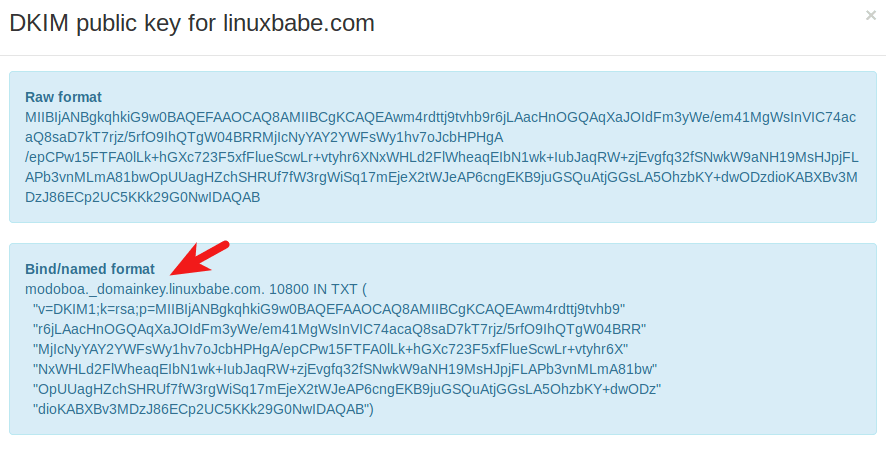
Go to your DNS manager, create a TXT record, enter modoboa._domainkey in the Name field. (Recall that we used modoboa as the selector when adding domain name in the admin panel.) Copy everything in the parentheses and paste into the value field. Delete all double quotes. Your DNS manager may require you to delete other invalid characters, such as carriage return.
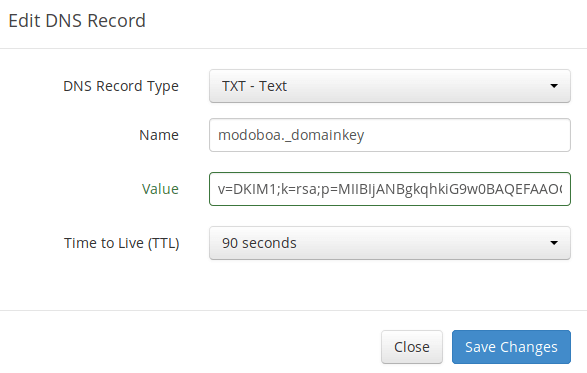
Note that your DKIM record may need sometime to propagate to the Internet. Depending on the domain registrar you use, your DNS record might be propagated instantly, or it might take up to 24 hours to propagate. You can go to https://www.dmarcanalyzer.com/dkim/dkim-check/, enter modoboa as the selector and enter your domain name to check DKIM record propagation.
DMARC Record
DMARC stands for Domain-based Message Authentication, Reporting and Conformance. DMARC can help receiving email servers to identify legitimate emails and prevent your domain name from being used by email spoofing.
To create a DMARC record, go to your DNS manager and add a TXT record. In the name field, enter _dmarc. In the value field, enter the following:
v=DMARC1; p=none; pct=100; rua=mailto:[email protected]
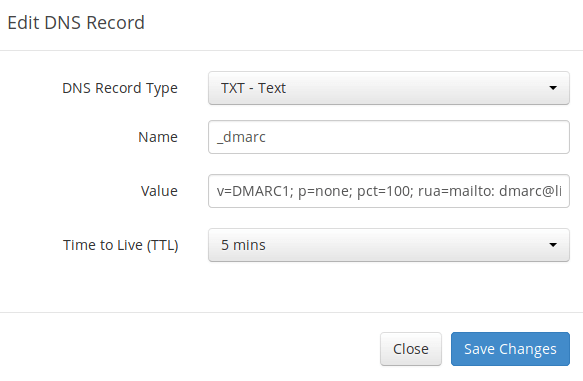
The above DMARC record is a safe starting point. To see the full explanation of DMARC, please check the following article.
Step 9: Testing Email Score and Placement
After creating PTR, SPF, DKIM record, go to https://www.mail-tester.com. You will see a unique email address. Send an email from your domain to this address and then check your score. As you can see, I got a perfect score.
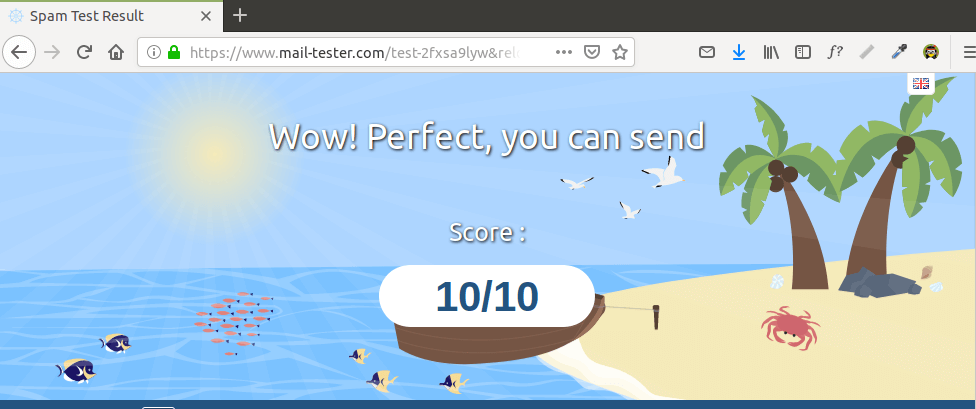
Mail-tester.com can only show you a sender score. There’s another service called GlockApps that allow you to check if your email is placed in the recipient’s inbox or spam folder, or rejected outright. It supports many popular email providers like Gmail, Outlook, Hotmail, YahooMail, iCloud mail, etc
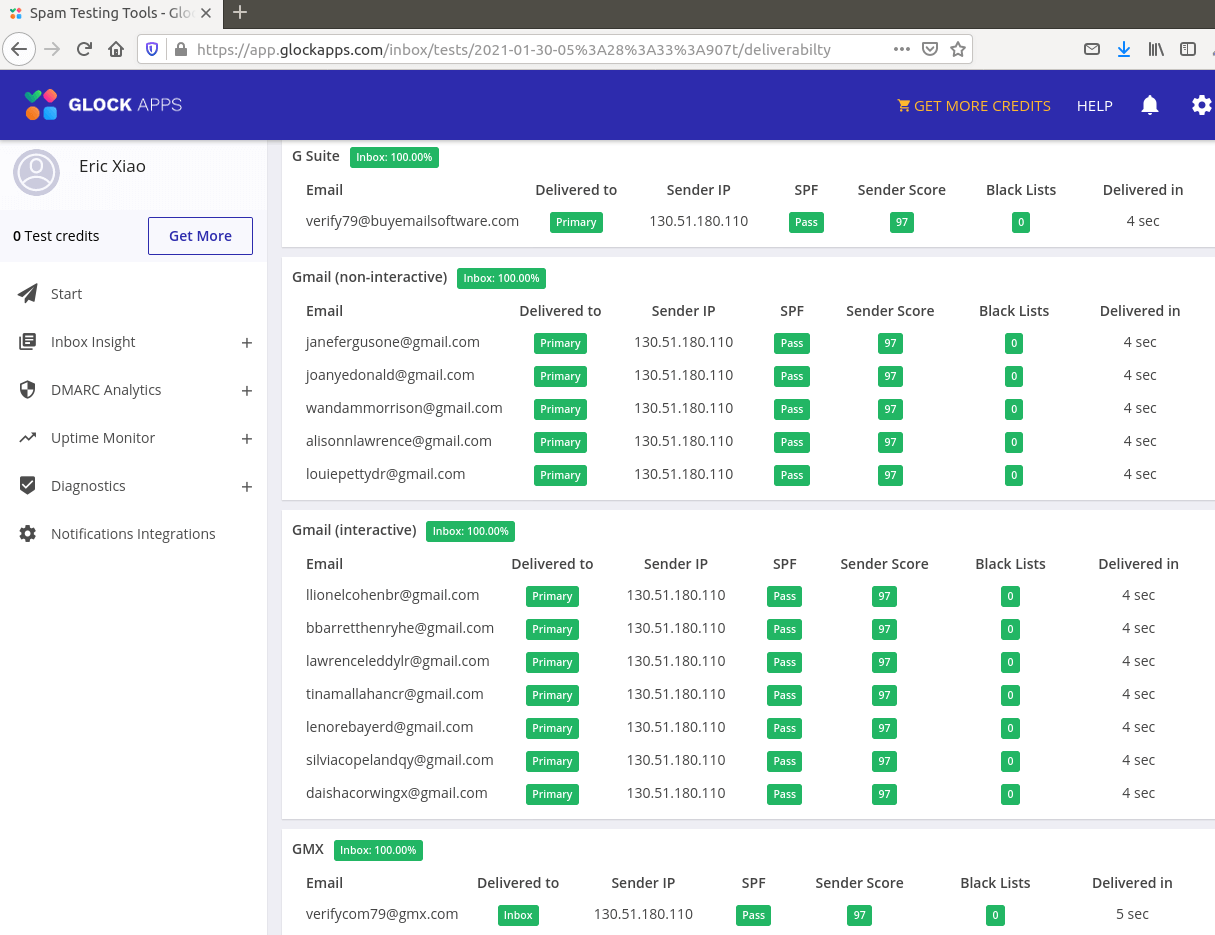
Email is Rejected by Microsoft Mailbox?
Microsoft uses an internal blacklist that blocks many legitimate IP addresses. If your emails are rejected by Outlook or Hotmail, you need to follow the tutorial linked below to bypass Microsoft Outlook blacklist.
What if Your Emails Are Still Being Marked as Spam?
I have more tips for you in this article: How to stop your emails being marked as spam. Although it requires some time and effort, your emails will eventually be placed in inbox after applying these tips.
Auto-Renew Let’s Encrypt TLS Certificate
Modoboa installed the latest version of Let’s Encrypt client (certbot) as /opt/certbot-auto. Let’s Encrypt TLS certificate is valid for 90 days. To automatically renew the certificate, edit root user’s crontab file.
sudo crontab -e
Add the following line at the end of this file.
@daily /opt/certbot-auto renew -q && systemctl reload nginx postfix dovecot
Save and close the file. This tells Cron to run the certbot renew command every day. If the certificate has 30 days left, certbot will renew it. It’s necessary to reload Nginx web server, Postfix SMTP server and Dovecot IMAP server so they can pick up the new certificate.
Enabling SMTPS Port 465
If you are going to use Microsoft Outlook client, then you need to enable SMTPS port 465 in Postfix SMTP server.
Troubleshooting
First, please use a VPS with at least 2GB RAM. Running Modoboa on a 1GB RAM VPS will cause the database, SpamAssassin, or ClamAV to be killed because of out-of-memory problem. If you really want to use a 1GB RAM VPS, you are going to lose incoming emails and have other undesirable outcomes.
If the Modoboa web interface isn’t accessible, like a 502 gateway error, you should check the Nginx logs in /var/log/nginx/ directory to find clues. You may also want to check the mail log /var/log/maillog.
Check if the various services are running.
systemctl status postfix systemctl status dovecot systemctl status nginx systemctl status mariadb systemctl status clamd@amavisd systemctl status amavisd
I found that the clamav-daemon service has a tendency to stop without clear reason even when there’s enough RAM. This will delay emails for 1 minute. We can configure it to automatically restart if it stops via the systemd service unit. Copy the original service unit file to the /etc/systemd/system/ directory.
sudo cp /lib/systemd/system/clamav-daemon.service /etc/systemd/system/clamav-daemon.service
Then edit the service unit file.
sudo nano /etc/systemd/system/clamav-daemon.service
Add the following two lines in the [service] section.
Restart=always RestartSec=3
Like this:
[Service] ExecStart=/usr/sbin/clamd --foreground=true # Reload the database ExecReload=/bin/kill -USR2 $MAINPID StandardOutput=syslog Restart=always RestartSec=3
Save and close the file. Then reload systemd and restart clamav-daemon.service.
sudo systemctl daemon-reload sudo systemctl restart clamav-daemon
(Optional) Set Up Autodiscover and AutoConfig to Automate Mail Client Configuration
Autodiscover and AutoConfig make it easy to configure a desktop or mobile mail client. The end user just need to enter a name, email address and password to set up his/her mail account, without having to enter the SMTP or IMAP server details. Autodiscover is supported by Microsoft Outlook mail client and AutoConfig is supported by Mozilla Thunderbird mail client.
Modoboa uses AutoMX to implement this feature on your mail server. All we need to do now is add CNAME records in DNS. In your DNS manager, create two CNAME records.
autoconfig.yourdomain.com CNAME mail.yourdomain.com autodiscover.yourdomain.com CNAME mail.yourdomain.com
Go to the Domains tab in your Modoboa admin panel, if the autoconfig is in green, that means your CNAME records are correct. (Modoboa checks DNS records for your mail server every 30 minutes, so you might need to wait some time for autoconfig to turn green.)

Once the CNAME records are propagated to Internet, you don’t have to enter the SMTP or IMAP server details when setting up mail account in Microsoft Outlook and Mozilla Thunderbird.
Host Multiple Domains in Modoboa
See the following article:
For Advanced Users
You may want to customize the SpamAssassin content filter to better detect spam.
If your website and mail server are running on two different VPS (virtual private server), you can set up SMTP relay between your website and mail server, so that your website can send emails through your mail server. See the following article.
Wrapping Up
I hope this tutorial helped you set up a mail server on CentOS 7 with Modoboa. As always, if you found this post useful, then subscribe to our free newsletter to get more tips and tricks. Take care 🙂
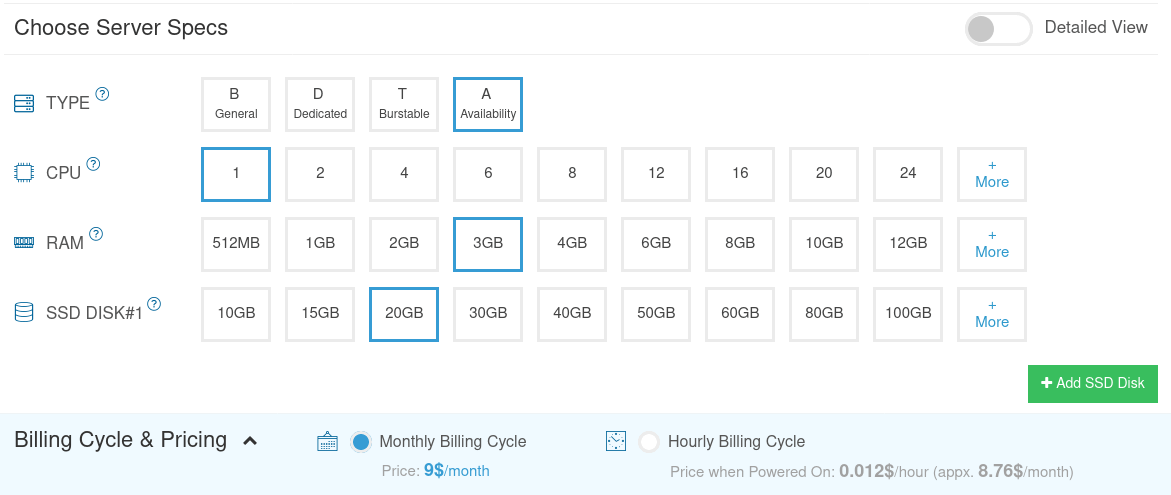



I mentioned this in the article, but I want to say it again: The best practice to run Modoboa is using a clean fresh OS.
Generally speaking, if there’s a script that will install lots of software, it’s a good practice to install it on a clean freash OS. Otherwise, the install script might mess up the existing configurations of your software, making it unusable. Or maybe a component of the softwar stack needs to bind to a port, but it’s already been taken by an existing process on the server, resulting in installation failure.
Unless you are very knowledgeable about every piece of software on the server and can spead lots of time debugging, it’s not recommended to install Modoboa on a server that has other applications running.
I have seen many folks who didn’t follow this advice bork the applications on their servers.
In your opinion, which email server is better for my ubuntu server. Is it Modoboa, iRedMail, Postfix, or Mailtrain?
Modoboa and iRedMail are scripts that make it easy to install and configure various components of a mail server. Personally, I prefer Modoboa, because it allows you to easily create alias in the web-based admin panel.
Postfix is a just a SMTP server.
Mailtrain is a newsletter application.
After successfully running the installation script without any errors, I was not able to open that link mail.my.domain, so I started investigating. First thing I found was that letsencrypt live folder was not even created, so Nginx failed to start:
Hi KarlBaumann!
I have had a similar problem. You must pay close attention to this:
Warning: Before you start the installation, please make sure the following DNS records exist for domain 'kriyanesia.id': mail IN A IN MX mail.kriyanesia.id.Just ping your mail.domain.com and make sure you get a reply from the correct ip before starting to install.
Hi, I’ve tried to install modoboa mail server following your instructions a couple of times, when the installation finishes and i open the browser and type in mail.mydomain.com the page loads but all the css and image files won’t load. I’ve checked the nginx conf and modoboa conf the file paths are right and the files do exist but my browser returns a 404 status code for the css and image files…
Solved,
I had to change the owner of the files to nginx…
Can you share what file/directory permissions you changed? I have the exact symptoms and unfortunately don’t have the skills to solve this problem.
Got my little brother involved and he turned off SELinux and fixed the problem, at least temporarily. Maybe it is a DigitalOcean-specific issue, I failed to the Ubuntu version of this tutorial to work but it did using a Ubuntu VPS on Kamatera.
Any least I can now log in and continue with the tutorial (which by the way I find to be great) and figure out my options..
If I have SSL certificate from PositiveSSl, what should I enter under [certificate] type? Do I have to use letsencrypt SSL?
Modoboa supports auto-configuring its own self-signed certificate and Let’s Encrypt certificate. You can use Let’s Encrypt certificate, since it’s free, easy to set up and can be automatically renewed.
If you really want to use PositiveSSL certificate, you need to manually replace the certificate file and private key file after installation, in the Postfix, Dovecot, and Nginx configuration file.
PS: I don’t think PositiveSSL, or other SSL certificate, would provide any extra benefits compared to Let’s Encrypt SSL certificate when you run an email server.
Your mail throughput is low. (0.73 email per second)
/\ When testing with Mailster (WordPress plugin)
Why?
Perhaps your server doesn’t have enough RAM to process bulk emails. Amavis and ClamAV will use lots of CPU and RAM when you send bulk email.
Amavis and ClamAV use about 1.3GB RAM and they will use more when sending bulk email. If you don’t need AntiVirus on your mail server, you can disable Amavis and ClamAV. This will save you 1.3GB RAM.
Edit Postfix master configuration file.
Find the following lines in this file and comment them out.
Save and close the file. Then restart Postfix.
Now you can stop Amavis and ClamAV.
And disable auto-start at boot time.
Hello,
I followed the instructions exactly and after the install finishes I am told to go to mail.mydomain.net to access the admin panel but when I go to the webpage I get “Internal Server Error” and nothing else.
I installed on CentOS 7 fresh install, using the installer listed above. I used MySQL as DB, and nginx as web server.
Not sure what I am doing wrong. Do I need to be on the same LAN to access? I am currently trying from a different LAN.
Hi Rob,
The latest version of Modoboa is a little buggy on CentOS 7. I recommend reinstalling the OS and using iRedMail to set up the mail server on CentOS 7.
Would you please upload a tutorial install the same mail server on centos 8? I’ll really appreciate your quick response.
Modoboa currently doesn’t support CentOS 8. I recommend using iRedMail on CentOS 8.
Had issues until following guidance from https://stackoverflow.com/questions/64388515/amavis-is-not-installed-centos
1. go to folder where you cloned modoboa git repo and run:
sed -i ‘s/amavisd-new/amavis/g’ ./modoboa-installer/modoboa_installer/scripts/amavis.py
2. cp modoboa-installer/modoboa_installer/scripts/files/amavis/amavis_mysql_2.11.X.sql modoboa-installer/modoboa_installer/scripts/files/amavis/amavis_mysql_2.12.X.sql
Perpetually in the “Awaiting checks” phase. Have created all records in DNS.
All services are running. Created a few scripts to check the mx and update the stats.
This only leads to more issues.
#!/bin/bash
PYTHON=/srv/modoboa/env/bin/python
INSTANCE=/srv/modoboa/instance
$PYTHON $INSTANCE/manage.py update_statistics
[root@mail scripts]# ./updatestats.sh
Traceback (most recent call last):
File “/srv/modoboa/instance/manage.py”, line 21, in
main()
File “/srv/modoboa/instance/manage.py”, line 17, in main
execute_from_command_line(sys.argv)
File “/srv/modoboa/env/lib64/python3.6/site-packages/django/core/management/__init__.py”, line 381, in execute_from_command_line
utility.execute()
File “/srv/modoboa/env/lib64/python3.6/site-packages/django/core/management/__init__.py”, line 375, in execute
self.fetch_command(subcommand).run_from_argv(self.argv)
File “/srv/modoboa/env/lib64/python3.6/site-packages/django/core/management/base.py”, line 323, in run_from_argv
self.execute(*args, **cmd_options)
File “/srv/modoboa/env/lib64/python3.6/site-packages/django/core/management/base.py”, line 364, in execute
output = self.handle(*args, **options)
File “/srv/modoboa/env/lib64/python3.6/site-packages/modoboa/maillog/management/commands/update_statistics.py”, line 84, in handle
self.update_account_creation_stats(options[“rebuild”])
File “/srv/modoboa/env/lib64/python3.6/site-packages/modoboa/maillog/management/commands/update_statistics.py”, line 79, in update_account_creation_stats
rrdtool.update(str(db_path), *data)
rrdtool.OperationalError: /srv/modoboa/rrdfiles/new_accounts.rrd: illegal attempt to update using time 1610499600 when last update time is 1610499600 (minimum one second step)
Thanks very interesting blog!
Because the admin of this site is working, no doubt very soon it will be famous, due to its quality
contents.
Why can’t you just buy the VPS and then ask cPanel be installed in the server by the vendor instead of going through all this troubles. You can still send bulk mail by configuring the webmail smtp in the cPanel. Or is there any difference if the idea is to send bulk mail. You only need the bulk mail guide lines etc.